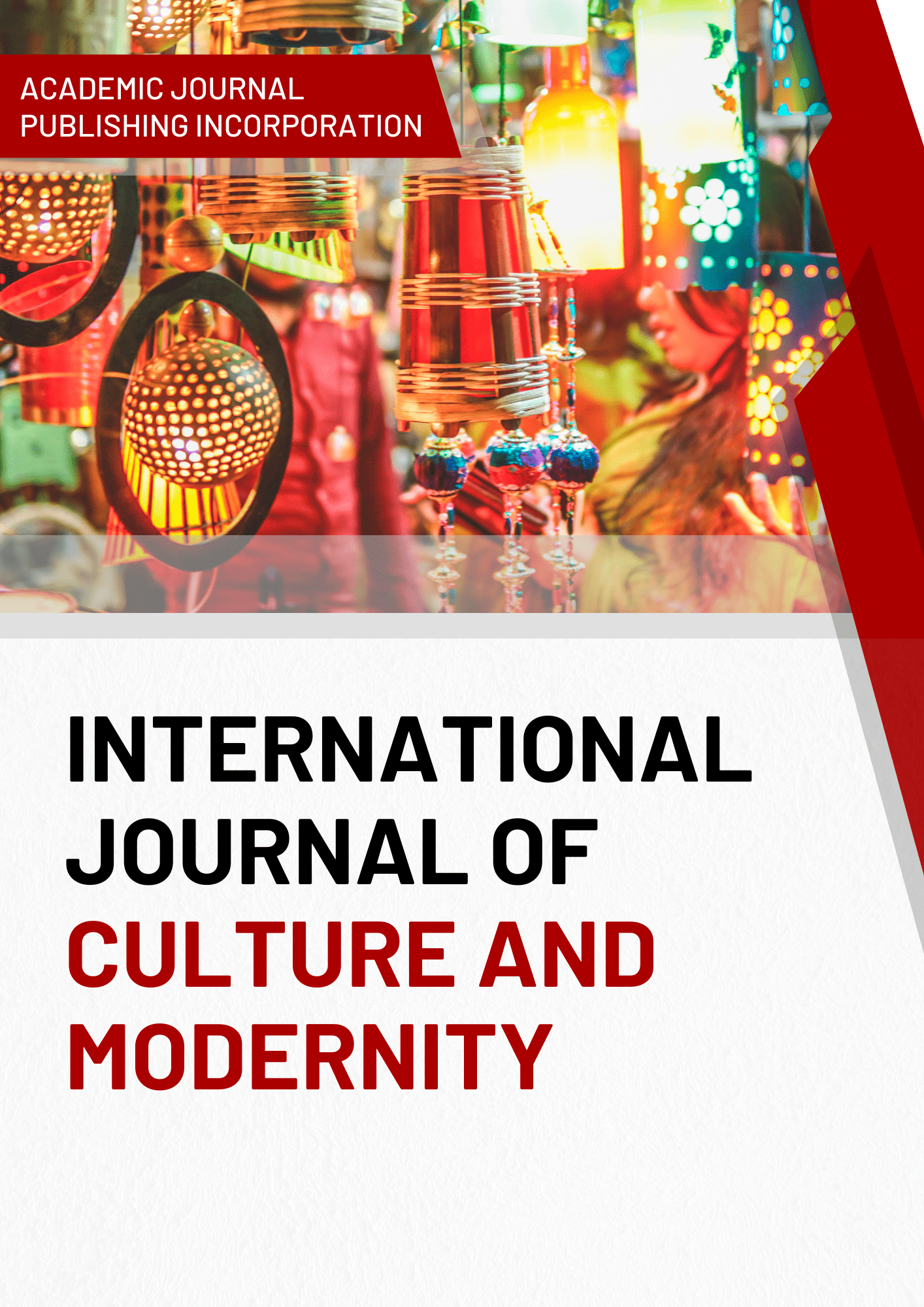In the Gazelles of Navoi Artical Images
DOI:
https://doi.org/10.51699/ijcm.v17i.288Keywords:
Means of expression, expression, trope, figure, rhetoric, animation, comparison, metaphor, metonymy, synonymAbstract
This article discusses the importance of artistic expressive means and their importance in unlocking the potential of the Uzbek literary language. A study of the works of Alisher Navoi on Uzbek linguistics contains information about the study. The poetry of Alisher Navoi considers analogous constructions used as means of artistic representation, and also analyzes the views of Uzbek linguists on the concept of image and means of expression. At the same time, the means of artistic representation of the language associated with the transfer of meaning are discussed.
References
Karimov I. High spirituality is an invincible force. − Tashkent: Spirituality. 2008, 108 p.
Alisher Navoi. Encyclopedic dictionary.Vol. –Tashkent: Sharq, 2016. 365-455-p.
Kungurov R. and b. Fundamentals of speech culture and methodology. − T., 1992.97-b
Ibragimova E. Some comments on the naming of artistic means // Uzbek language and literature. 2009, № 2, 89-p.
Sultan I. Literary theory. − T., 1986. 216-b.
Quronov D. Introduction to Literary Studies. − Andijon, 2002. 116-p.
Ibragimova E. Some comments on the naming of artistic means // Uzbek language and literature.2009, № 2, 89-p.
Xudoyberdiev E. Introduction to Literary Studies. –T., 2003. 123, 132-p.
Shomaqsudov A. and b. Uzbek language stylistics. − T., 1983. 248-p.
Kungurov R and b. Fundamentals of speech culture and methodology. − T., 1992; Kungurov R. Visual aids of the Uzbek language. −T., 1977.
Yuldashev M. Secrets of the word Cholpon. −T., 2002.
Qosimova M. Linguistic features of the individuality of artistic speech (based on the works of T. Murodov). NDA. − T., 2007. 23-p
Ibragimova E. Some comments on the naming of artistic means // Uzbek language and literature. 2009, № 2, 90-p.
Ibragimova E. Uzbek language and literature // Some comments on the naming of artistic means. 2009, № 2, 90-p.
Umarova N.R. Expression of cause and effect relationship in Alisher Navoi’s poems: NDA.− Fergana, 2005.
Umarova N.R. (2020). The concept “word” in the works of Alisher Navoi. Scientific Bulletin of Namangan State University, 2(11), 256-262.
Umarova N.R. (2020). The interpretations of the nation “concept”. ERPA international journal of multidisciplinary research (IJMR), 6, 437-439.
Umarova N.R. (2021). The use of artistic anthroponyms in the poems of Alisher Navoi. Theoretical & Applied Science, (5), 419-421.
Rustamovna U.N., & Alisherovna A.N. (2021). Mention of plant names in the poems of Alisher Navoi. ResearchJet Journal of Analysis and Inventions, 2(06), 371-375.
Rustamovna U.N., & Turdalievich Z.M. (2020). Frame Structure of The Concept “gold” in Navoi's Poem “Iskander’s wall”. Iranian Journal of Language Teaching Research, 9(16), 346-357.
Amonov, M. U. (2021). On Arab borrowings, denoting the name of the profession, which is actively used in the Uzbek language. ISJ Theoretical & Applied Science, 11(103), 863-866.
Амонов, М. (2016). АЛИШЕР НАВОИЙ ҒАЗАЛЛАРИДА ҚЎЛЛАНИЛГАН АРАБИЙ ИЗОФАЛАРНИНГ ТУРЛАРИ. Актуальные научные исследования в современном мире, (6-1), 91-94.
Amonov, M., & Azizova, F. (2022). Thematic Groups of Arabic Words in Boburnoma. International Journal of Culture and Modernity, 13, 82-89.
Нурманов, А., & Искандарова, Ш. (2008). Тилшунослик назарияси. Тошкент: Фан.
Искандарова, Ш. (1998). Лексикани мазмуний майдон асосида ўрганиш муаммолари. Т.: Фан, 7.
Iskandarova, S., & Tursunova, D. (2022). SEMANTICS OF ASSOCIATIVE RELATIONS IN THE POETRY OF ERKIN VOKHIDOV. Oriental Journal of Social Sciences, 2(02), 25-31.
Iskandarova, S. M., & Khudoykulova, U. A. (2016). EXPRESSING DIFFERENTIAL SEMES IN RIDDLES. Ученый XXI века, (3-4), 28-31.
Kuldashev, N., Avazbek, D., & Parviz, A. (2022). Opinions of Our Ancestors on Language and Speech Purity. Journal of Ethics and Diversity in International Communication, 2(4), 10-16.
Ibragimova, E. I., Zokirov, M. T., Qurbonova, S. M., & Abbozov, O. Q. “Filologiyaning dolzarb masalalari” mavzusidagi Respublika ilmiy-amaliy internet-konferensiya materiallari: Ilmiy ishlar to‟ plami.–Farg‟ ona, 2018.–113 sahifa.
Turdaliyevich, Z. M., & Farhod, I. (2022). Loiq Is the Successor of the Great Figures Of Tajik Literature. International Journal of Culture and Modernity, 14, 51-55.
Maftuna, G. (2022). Methodology of Organizing Problem Lessons in Higher Education. International Journal of Culture and Modernity, 14, 72-77.
Khamrakulova, S., & Zokirov, M. T. (2022). Phraseological units expressing old age of a human being in the English and Russian languages. ISJ Theoretical & Applied Science, 1(105), 280-283.
Zokirov, M. T. (2019). About the general characteristic of bilinguism. Scientific Bulletin of Namangan State University, 1(10), 260-265.
Zokirov, M. T. (2021). ABOUT THE INTERRELATIONSHIPS OF LINGUISTICS AND PSYCHOLOGY. Theoretical & Applied Science, (4), 422-425.
Turdaliyevich, Z. M. (2022). Actual Problems of Bilingualism in a Multi-Ethnic Environment. International Journal of Culture and Modernity, 13, 17-23.
Zokirov, M. (2007). Lingvistik interferensiya va uning o'zbek-tojik bilimimizda namoyon bo'lishi. MDA-Toshkent.
Kuldashev, N. ., Parviz, A. ., & Avazbek, D. . (2022). Fazli Namangani’s “Majmuai Shoiron” Review Zullisonayn Issue. Spanish Journal of Innovation and Integrity, 6, 429-433.
Gulrux, J. ., Maftuna, G. ., E’zozxon, O. ., Muhabbat, U. ., & Abdumalik, S. . (2022). The Method of Onomastic Conversion in the Formation of Toponimes in the Fergana Region. Spanish Journal of Innovation and Integrity, 6, 451-456.
Porubay, I. F., & Ibragimova, E. I. (2021). ABOUT THE FEATURES OF SOCIAL MEDIA DISCOURSE (BASED ON THE EXAMPLES OF RUSSIAN AND ENGLISH LANGUAGES). Theoretical & Applied Science, (12), 482-486.
Ibragimova, E. I. (2020). Aesthetic function of relationships of the addressant. ISJ Theoretical & Applied Science, 05 (85), 101-104.
Sayyora, Q. (2022). FORMATION OF TEXT ANALYSIS IN LINGUISTICS. Modern Journal of Social Sciences and Humanities, 4, 58-61.







